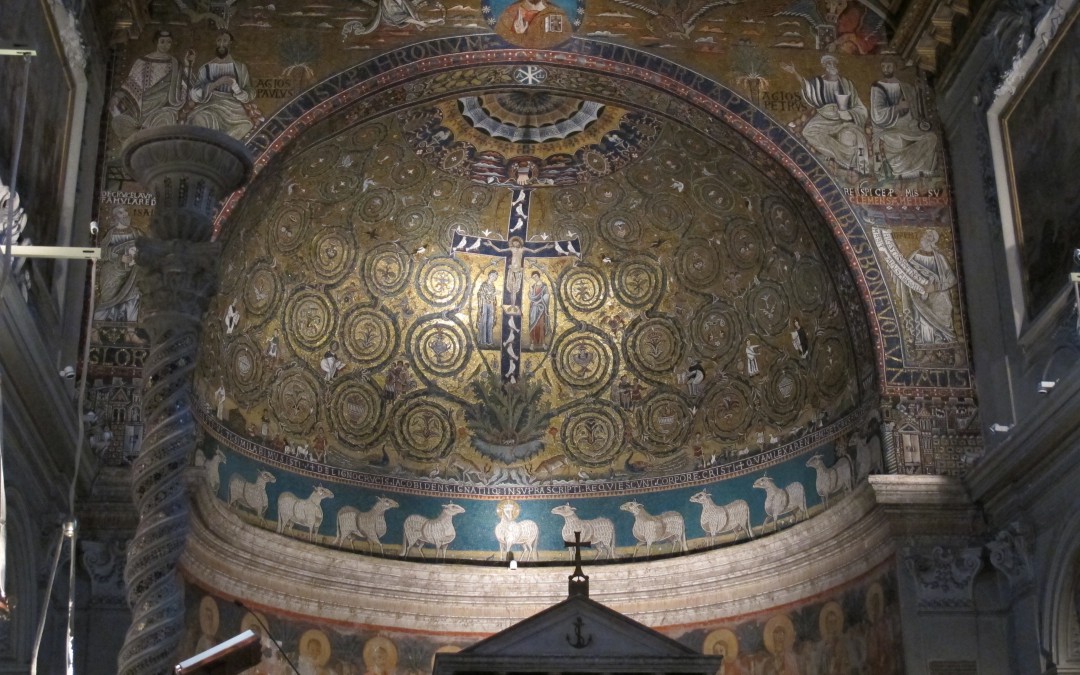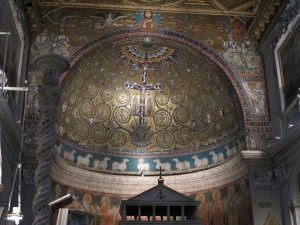On Monday morning I was exploring underground sites on the Caelian Hill with a charming couple from California. We started off a stone’s throw from the Colosseum at the church of San Clemente where layer upon layer of the city’s history can be explored; a veritable time machine.
Imperial Roman buildings lie beneath a fourth century church, which was, in turn, buried to become the foundations of a twelfth century church. That twelfth century church (with exquisite apse mosaics, about which more here) would find itself catapulted into disrepair within two centuries and would be partially saved by the intervention of Cardinal Branda da Castiglione in the first half of the fifteenth century.
Scion of a noble Milanese family, the Cardinal had first arrived in Rome in 1389 to lobby for a Papal Bull of Foundation for the University of Pavia. He arrived in a city brought to its knees. Eighty years earlier the levels of violent feuding for control of Rome were such that Pope Boniface VIII had been brutally kidnapped by the powerful Colonna family and subsequently died of his injuries.
Two years later, in 1305, the French Clement V was elected, and crowned in France. In 1309 he yielded to pressure from Philip IV of France and settled with the curia at Avignon then under the control of Philip’s vassals, the Angevin kings of Naples. For seventy years the papal court thrived at Avignon and, far from the horrors of Rome, a culturally fertile environment developed.
Meanwhile, for the Eternal City decades of struggle and neglect were to follow. In 1377 Pope Gregory XI returned to Rome in an attempt to regain control of the papal seat. However upon the death of Gregory, and the election of his successor Urban VI in the following year, discord once again reigned. The French cardinals, unhappy at what they perceived as a forced result, left Rome and elected Robert of Geneva, who took the title Clement VII. The French court then returned to Avignon where they continued to elect their candidates, whilst the curia in Rome chose theirs. Those subsequently deemed to have been unjustly elected in France were declared to be ‘anti-popes’.
In Rome, the period of the Avignon papacy was horrific; violent struggles and war were amplified by natural disasters, most notably the great earthquake of 1347 followed in 1348 by the Black Death. The city was peopled by the four horsemen of the Apocalypse. Rome’s urban fabric suffered enormously; damage caused by both man and nature was exacerbated by the correspondent lack of maintenance of the city and its churches by an absent papacy. San Clemente was no exception, and in 1395 a request for funds granted by Pope Boniface IX refers to the church as being in such a poor condition that its collapse threatened to block the street. Just a few years after these repairs the church passed to the Order of Friars of St Ambrose ad Nemus.
It was under their aegis when Branda da Castiglione, who had remained in Rome having acquired the Bull he sought, was granted the title of cardinal of San Clemente in controversial circumstances. In 1411 the Council of Pisa had attempted to resolve the problem of having two claimants to the papacy, however rather than resolve the Schism the meeting had instead elected a third Pope (later declared anti-pope), who took the title John XXIII. It was he who created Branda da Castiglione as titular Cardinal of San Clemente on 11th June, 1411 overriding the incumbent titular cardinal – the future Pope Eugene IV. The dubious claim of John XXIII, and the presence of an existing titular cardinal, left Castiglione’s role at San Clemente unclear to say the least.
Uncertain or not, he nevertheless began work on the church with the construction and decoration of the chapel which bears his name. Work is estimated to have taken place between 1428 and 1431. Certainly Castiglione’s subsequent appointment as Cardinal-Bishop of Porto in 1431 suggests work was finished by that date. By this stage the air in Rome was altogether clearer; in 1417 Oddone Colonna had been elected Martin V (the Colonna were, it transpired, only anti-papal until they had themselves a pope), and three years later his return to the city saw the beginning of the programme of repairs which was to mark the beginning of the end of the Middle Ages in Rome.
Martin called for help in this mammoth project of restoration and redecoration, and Cardinal Branda da Castiglione’s chapel can be seen as a response to this request. The chapel is a rare example of a surviving and complete project from this period of the nascent Renaissance.
Part of the left aisle was walled in to create a square space and the chapel’s decoration was entrusted to Masolino da Panicale di Valdelsa. He is thought to have begun work at San Clemente c.1428, soon after completing the Brancacci Chapel at Santa Maria del Carmine in Florence.
Standing in the left aisle, with one’s back to the main altar, the first view one gets of the chapel shows the Annunciation directly above the pointed archway. The angel Gabriel and the Virgin Mary are shown housed within a building supported on the rather spindly columns which are so characteristic of the Early Renaissance.
Writing a century later in the preface of his “Lives of the Artists”, from the lofty heights of one who had witnessed the High Renaissance first-hand, Giorgio Vasari said that the medievals had made columns as tall or as short as they wished, ignoring the rules on proportion which had governed the buildings of Vitruvius and the ancients. In the thin columns of the Early Renaissance (as seen in Brunelleschi’s Ospedale degli Innocenti in Florence, under construction while Masolino was painting at San Clemente, and often considered the first building of the Renaissance) we can see the first tentative steps on a route towards the confident forms which would culminate at the Tempietto of Bramante almost a century later.
Masolino was painting at San Clemente about three years after Filippo Brunelleschi’s development in Florence of the one-point perspective system. These developments in perspective are central to the Early Renaissance, the two-dimensional abstraction of the Middle Ages was already a distant memory and the ‘rebirth’ of the ancient was finding its feet, and moving towards a solid and logical material certainty.
- Annunciation, detail, Branda Castiglione Chapel
In the scene of the Annunciation, the ever diminishing painted coffers of the ceiling – realistically observed as if from below, as we in fact see it – serve to delineate the application of the newly developed systems of perspective. The return to the order and rationality perceived in every aspect of the Ancient world, from politics to poetry, was represented in the visual arts with an accurate representation of our place within the material world. In fact the classicism of the architectural setting of the Annunciation above the arch is somewhat at odds with the pointed Gothic nature of the stone and mortar arch itself. This juxtaposition serves as a fine illustration of the chapel’s importance in Roman art as a bridge between the Middle Ages and the Renaissance.
Cappella Branda Castiglione
Basilica di San Clemente
via di San Giovanni in Laterano
Open daily 9-12, 4-7






Trackbacks/Pingbacks